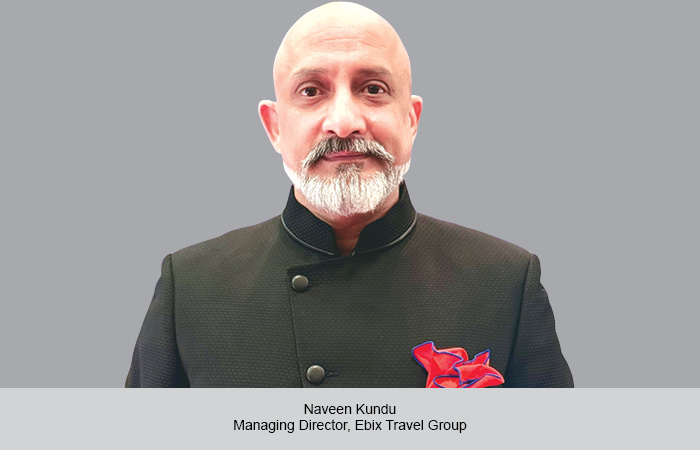 By: Shikhar Aggarwal, Joint Managing Director, BLS International
By: Shikhar Aggarwal, Joint Managing Director, BLS International
India is blessed with unmatched cultural diversity, rich heritage, and natural wealth, which have the potential to make the country one of the most compelling travel destinations. From the snow-capped Himalayas to the picturesque backwaters of Kerala, from the magnificent forts of Rajasthan to vibrant and lively metropolises such as Delhi and Mumbai, the country offers unique experiences that no other nation can rival.
Untapped Potential
Yet, despite these enormous offerings, India’s tourism sector contribution is only about 5% to GDP (around $250 billion annually)1. It is significantly lower than other major global tourist destinations such as Spain and Thailand, where earnings from the sector account for around 16% and 10% of their respective economies.
These numbers point to the vast growth potential available to India’s tourism industry, and to fully harness this opportunity, there is an urgent need to ramp up investments in world-class travel infrastructure to unlock its tourism potential.
And the country should focus more on building world-class infrastructure, along with measures such as streamlining the visa process to make visiting India a memorable and pleasant experience.
Moreover, as a nation, we have embarked on an ambitious goal to become a developed nation by 2047, and the tourism sector has already been recognised as a key economic driver in its Tourism Vision 2047 roadmap.The sector is projected to generate $3 trillion in economic value, create 200 million jobs, and host 100 million foreign visitors and 20 billion domestic travellers by 2047.
Developing World-Class Infrastructure
Achieving such an ambitious target requires accelerating investment in developing world-class airports, in modernising rail and road networks, in upgrading public amenities, and vibrant recreational infrastructure such as hotels, resorts, and camping sites to create a seamless and memorable experience for travellers.
Travel infrastructure is the backbone of tourism, and in recent years, India has made significant strides. The country today has 220 airports5, placing it among the top ten aviation markets globally with a size of $16 billion. The rapid expansion of India’s aviation sector is further solidified by the government’s other initiatives, such as UDAN, which has made air travel far more affordable for millions of Indians and helped promote underserved tourist destinations across the country.
Simultaneously, ambitious projects to develop cruise and island tourism in locations such as
Lakshadweep and the Andaman & Nicobar Islands are helping in unlocking new potentials in the country’s tourism sector.To further accelerate this momentum, seamless multimodal connectivity, integrating all aspects of travel such as air, sea, rail, and road networks, must be at the centre stage of India’s tourism strategy in the future.
Encouraging Initiatives
Additionally, in the hospitality sector, regarded as an essential pillar of the tourism industry, it is very encouraging to see progress with the government’s decision to grant infrastructure status to hotel projects at 50 tourist destinations5. This is indeed a welcome move, but there is a need to do more to give a boost to the tourism sector.
The government’s move to MUDRA4 loans for homestays, investments in enhancing connectivity, and measures taken to streamline visa processes will likely boost the country’s tourism sector, making travel to India a more pleasant experience.
Another key area, which needs urgent attention, is the development of budget-friendly and quality accommodations and improvement in public amenities.
While there are plenty of luxury and five-star hotels thriving in the vicinity of major tourist attractions and metropolitan cities, there is a need to invest more in developing budget-friendly, hygienic, and standardised accommodations across the country.
Public Amenities to Enhance Experience
For tourists, whether domestic or foreign, visiting any place in India, , the availability of clean public toilets, pedestrian-friendly pathways, and comfortable resting areas can greatly enhance their experience, allowing India’s rich cultural and natural attractions to provide immersive and unforgettable experiences to visitors.
By prioritizing the development of such facilities through public–private partnerships, India can dramatically enhance the travel experience and position itself to attract far greater numbers of visitors.
Acknowledging the potential of this sector, the government has allocated more than ₹5,0005 crore in the past two budgets to boost the tourism sector with an intent to focus on improving public infrastructure.
Improving travel infrastructure across the country will also allow companies to offer attractive theme-based packages such as adventure tourism, eco-tourism and sustainable tourism to position India as a year-round destination.
This will not only draw tourists with specific interests but also encourage repeat visits, giving India’s unique offerings a competitive edge over rival destinations.
The Way Forward
Globally, the tourism sector stands out for its ability to generate the maximum number of jobs per unit of investment compared to any other sector in a country.
And for a country like India, higher investments in improving public amenities and upgrading infrastructure will make the sector not only a driver of economic activity but also a powerful engine for providing employment to millions of Indians.
 TravTalk India Online Magazine
TravTalk India Online Magazine




